Femia > Health Library > Your cycle > Health > Bleeding during ovulation: Could it be a sign of pregnancy?
Bleeding during ovulation: Could it be a sign of pregnancy?
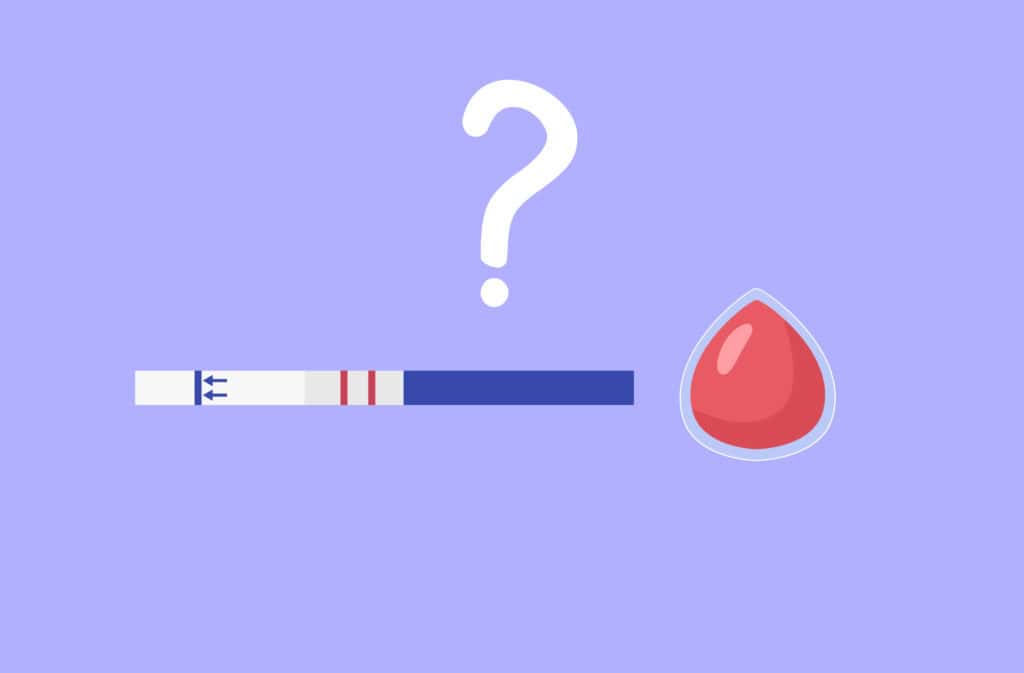
- Updated Mar 2, 2025
- Published
CRAFTED BY HUMAN
Crafted by human At Femia, we provide accurate and up-to-date information at every stage of your journey, from trying to conceive, pregnancy and postnatal support. All content is created by a real person based on in-depth research and own professional experience. Femia ensures that you will receive expert advice, strict accuracy and a personalized approach from our authors/medical experts. Learn more about our editorial policy.
FACT CHECKED
Fact checked At Femia Health, we maintain the highest standards of editorial excellence in delivering content focused on helping you conceive, guiding you through pregnancy, and supporting you postpartum. Explore our content review principles to learn how we ensure the accuracy and quality of our health and lifestyle tips for every stage of your journey.
Ovulation bleeding vs. implantation bleeding:
- Timing: Ovulation bleeding occurs mid-cycle (around day 14 in a 28-day cycle), while implantation bleeding happens 10-14 days after conception, closer to the next expected period.
- Frequency: Ovulation bleeding affects about 5% of women, while implantation bleeding occurs in 24% of early pregnancies.
- Duration: Both typically last 1-2 days and involve light spotting.
- Color: Both are usually light pink to red.
- Cause: Ovulation bleeding results from hormonal fluctuations, while implantation bleeding occurs when a fertilized egg attaches to the uterine lining.
Trying to conceive can be an exciting, and sometimes nerve-wracking, journey. If you’ve noticed some unexpected spotting between periods, you might be wondering what it means. Don’t worry, you’re not alone in this!
Many women experience light bleeding or spotting mid-cycle, and it can certainly keep you guessing. Is it a sign of ovulation? Could it be early pregnancy? It’s natural to feel a mix of hope and uncertainty.
Mid-cycle bleeding, which generally takes the form of light spotting, is most commonly associated with ovulation. It is frequently mistaken for pregnancy as 24% of early pregnancies experience bleeding, most often caused by implantation.
The good news is, there are ways to tell these two types of spotting apart. We’ll walk you through the differences in timing and bleeding patterns, so you can better understand what your body might be telling you.
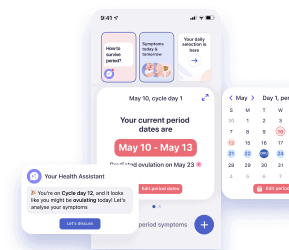
What is ovulation bleeding?
Ovulation takes place when one of your ovaries releases an egg. In a typical 28-day cycle, ovulation occurs midway through the cycle on day 14. Ovulation lasts for about 12 to 24 hours and is your peak window for fertilization with sperm. If you are trying to get pregnant, the five days before ovulation and the day of ovulation are your prime fertile window. Having unprotected sex every other day during your fertile window can drastically increase your chances of getting pregnant. If your egg isn’t fertilized in the 24 hours after ovulation, the egg disintegrates and is absorbed back into the body.
In a BioCycle Study, approximately 5% of women self-reported mid-cycle bleeding during or around the time of expected ovulation. Since ovulation bleeding is relatively uncommon, and can occur randomly or infrequently, it can easily be mistaken as a sign of something else. Spotting during ovulation is easily confused with the implantation bleeding noticed in early pregnancy.
How long does ovulation bleeding last?
Ovulation bleeding lasts for a day or two. A dramatic shift in hormones occurs around the time of ovulation as the menstrual cycle shifts from the follicular phase into the luteal phase. The sudden change in hormones can sometimes cause light spotting during ovulation. Some women may notice spotting only once during the day while some may notice light bleeding for a couple of days. Either way, the spotting should then subside on its own.
Looking for other signs of ovulation, like an increase in your basal body temperature and changes to your cervical mucus, can help link light bleeding to ovulation. Along with spotting during ovulation, 40% of reproductive-aged women also notice light cramping for a day or two around ovulation. You may feel it as a light spasm in your lower pelvis. Cramps are often set off to one side, indicating which ovary is releasing the egg.
👉Find out more: Signs of ovulation after stopping taking birth control pills
How much bleeding is normal during ovulation?
Bleeding around ovulation is usually light. Most women self-describe the bleeding as spotting. You may see a light pink discoloration on your underwear since it is often mixed with other cervical fluid. Ovulation bleeding rarely requires more than a couple of pads or tampons.
If you find yourself changing your period product several times a day because of heavy bleeding, it’s advisable to check in with your healthcare provider.
Other types of mid-cycle bleeding
If you are seeing mid-cycle bleeding for the first time, ovulation may not be the first thing you think of. Many other things can cause bleeding, like infections, UTIs, hormonal imbalances from birth control, conditions like PCOS, or taking new medications. These and other medical conditions can all result in spontaneous mid-cycle bleeding.
Ovulation bleeding is generally light, lasts for a couple of days, and resolves itself quickly and naturally. Therefore, if you are experiencing unexpected bleeding that follows a different pattern, you might be able to rule out ovulation bleeding. Keep a close eye out for any other symptoms! They will help you and your health provider determine the source of your bleeding. Consulting your doctor is important, they will help you assess if your bleeding is associated with ovulation, and together you can narrow down a possible cause for your bleeding, including a possible pregnancy.
👉Find out more: Can you get pregnant without a period?
Why am I bleeding during ovulation?
During ovulation, the body shifts from the follicular phase to the luteal phase. This means that there is a sudden drop in estrogen levels, followed by a rise in progesterone once your egg is released. This dramatic shift in your hormones can create instability in the uterine lining, which causes the light bleeding sometimes noticed around ovulation.
While it might seem like the bleeding is related to the release of the egg from your ovary, which often causes cramps, ovulation bleeding occurs because you are shedding some of the lining in your uterus. Any blood released while your egg is being released should be reabsorbed by your body. The rupture of the follicle during ovulation can be felt as a slight cramping in your lower pelvis.
In a BioCycle study of 470 menstrual cycles, mid-cycle spotting was recorded among women with significant hormonal shifts. Some of these hormonal shifts were identified as high estrogen levels around ovulation and the luteal phase, high luteal phase progesterone, and higher luteinizing hormone around ovulation.
Seeing spotting for the first time can be confusing, especially if you are trying to conceive. This is why, even though the spotting may seem negligible, it is always advisable to check in with your doctor. For women with short cycles, ovulation spotting and implantation bleeding may occur a few days apart, which may be impossible to distinguish without tests provided by your doctor.
Ovulation bleeding vs. implantation bleeding
Ovulation bleeding is caused by fluctuations in your hormones around ovulation, causing some of the lining of your uterus to shed.
Implantation bleeding, on the other hand, is the spotting you notice after a fertilized egg implants into your uterus.
Because of the similarities between ovulation bleeding and implantation bleeding, it might be easy for you to mistake one for the other, especially if this is the first time you’ve noticed mid-cycle spotting. Some of these similarities include:
- Spotting for 1-2 days;
- Pinkish to light red discharge;
- Mild lower abdominal cramping.
Ovulation bleeding vs implantation bleeding: The main distinction is when the spotting is noticed.
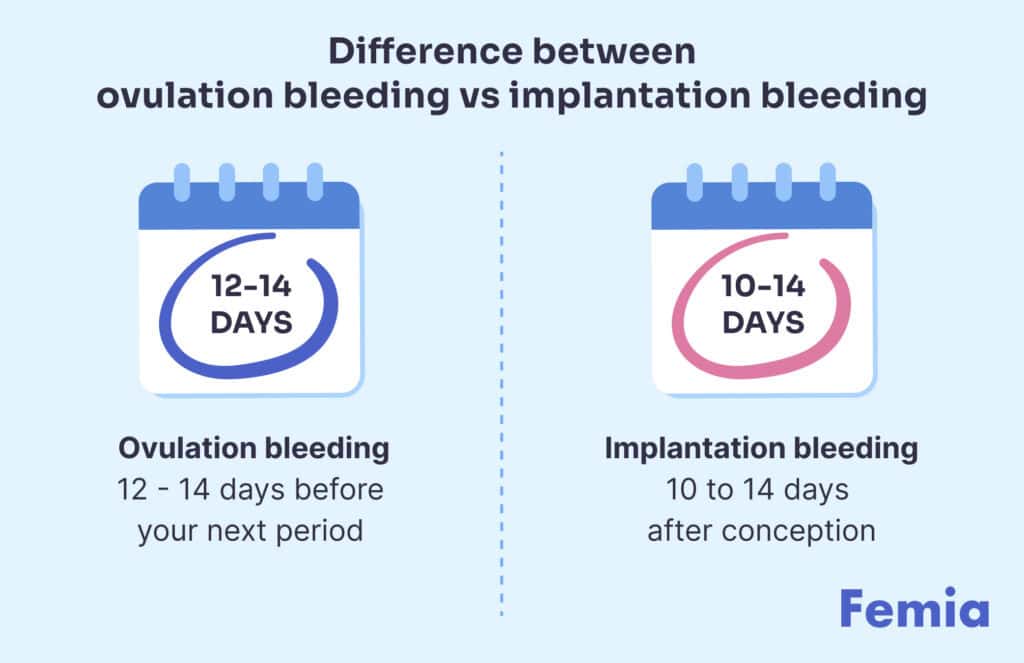
The majority of women are in their fertile window by day 12 of their menstrual cycle. Since ovulation doesn’t occur on a fixed day every cycle, it may happen at any time in your fertile window, lasting for about a week per cycle. So, noticing bleeding 12 to 14 days before your next period is due can be an indication of ovulation.
Implantation bleeding, on the other hand, happens closer to when your next period is due, 10 to 14 days after conception. Bleeding early in pregnancy, especially following implantation, is not unusual. Since implantation bleeding generally happens close to your expected period date, its timing makes for a vital distinction between ovulation bleeding.
👉Find out more: What are the chances of getting pregnant from precum while ovulating?
Can I be pregnant if I bleed during ovulation?
Bleeding between periods can be concerning, especially if it’s something you’ve never experienced before. If you’re trying to get pregnant, bleeding around the time of ovulation could have various causes, including ovulation bleeding, implantation bleeding, or other gynecological issues. However, if you are already pregnant, any bleeding might indicate a different set of concerns and should be discussed with a healthcare provider.
It’s important to note that while implantation bleeding and ovulation bleeding can be normal, any unscheduled bleeding should be evaluated by a healthcare provider to rule out other possible causes. Once other causes have been ruled out, and no serious issues are identified, unscheduled bleeding may be attributed to benign causes like implantation or ovulation bleeding.
When trying to determine whether or not mid-cycle bleeding might mean you’re pregnant, remember that ovulation bleeding happens either before or right after ovulation has taken place. This is in your fertile window, during which your chances of conception are the highest. This means it is highly unlikely that bleeding mid-cycle is an indication of pregnancy.
Many women report some bleeding in the first sixteen weeks of their pregnancy. This bleeding is noticed after a period has been missed and pregnancy is confirmed. Very early pregnancy bleeding can be mistaken for a period and may never be reported.
So, it is very rare that bleeding in your fertile window is associated with pregnancy. Since it can be hard to feel 100% sure, checking in with your doctor is a good idea. Seeing your provider can be helpful and give you answers any time you notice bleeding between your periods for the first time.
👉Find out more: How to conceive a boy: Exploring methods and understanding the chances
When should I worry about ovulation bleeding?
Ovulation bleeding is a normal phenomenon. Some people may see light bleeding during ovulation at the same time every month. This is approximately two weeks from the first day of the most recent period.
Irregular, heavy, or inconsistent bleeding should prompt you to consult your healthcare provider for personalized care.

When to seek medical advice
If you experience new or unexpected bleeding, it’s important to consult your healthcare provider. They can help determine whether the bleeding is due to ovulation, implantation, or another cause. Even light spotting can be concerning if you are trying to conceive, so seeking professional advice is always a good idea.
If you suspect you might be pregnant and are uncertain whether the bleeding is related to ovulation or implantation, your doctor can perform a simple blood test to confirm pregnancy and help identify the source of the bleeding.
For those with regular periods, heavy mid-cycle bleeding—such as soaking through a pad every hour—warrants prompt medical attention. Additionally, record any accompanying symptoms like pain, fever, unusual discharge, or recent medications, as these details can provide valuable clues to your doctor.
Remember, unscheduled bleeding can have various causes. Before assuming it’s due to ovulation or implantation, it’s essential to rule out more serious conditions through proper medical evaluation.
Questions from the Femia community
Can I have mid-cycle bleeding if I am on hormonal birth control?
If you are using hormonal birth control, such as the pill, mid-cycle bleeding isn't typically related to ovulation, as most hormonal contraceptives prevent ovulation. Instead, what you might experience is known as breakthrough bleeding. This can occur for several reasons, such as missing a pill, not taking the pill at the same time every day, or the hormone dose in the pill not being suitable for your body. Breakthrough bleeding is usually light and may subside on its own. However, if the bleeding is heavy or prolonged, or if you have concerns, it's important to consult your healthcare provider.
Is it possible to experience ovulation bleeding every cycle?
Bleeding during ovulation is considered rare, and reported among just 5% of women. Women who do record mid-cycle bleeding due to ovulation are likely to consistently notice it during every cycle. Light bleeding during ovulation is not a cause of concern. For reassurance, especially if you notice spotting for the first time, consult your doctor.
I have heavy bleeding during ovulation. Does this mean I am pregnant?
Heavy bleeding between periods can be concerning, especially if it involves soaking through a pad every hour or two. While heavy bleeding might occur in early pregnancy, it’s important to see a doctor to rule out other possible causes first. A healthcare provider can help determine the cause and provide appropriate care.
How can I track my ovulation and related symptoms accurately?
Regular tracking of menstrual cycles can help you narrow down ovulation symptoms, such as changes in cervical mucus consistency, elevation in basal body temperature, and mild cramping. You can use ovulation prediction kits along with ovulation tracking apps like Femia for regular monitoring of your fertile window every cycle.
The bottom line
Light bleeding during ovulation is completely normal but can be a source of confusion especially if you are trying to get pregnant. Ovulation bleeding occurs mid-cycle and will be noticed as light spotting on your underwear or toilet paper when you wipe. Early pregnancy bleeding, including implantation bleeding, is frequently observed after a missed period.
To better understand your symptoms, we advise you to track your menstrual cycles and the changes you notice during your cycle. Any bleeding you notice between your cycles, especially for the first time, should warrant a check-up with your healthcare provider.
References
- Hasan, Reem, et al. “Patterns and Predictors of Vaginal Bleeding in the First Trimester of Pregnancy.” Annals of Epidemiology, vol. 20, no. 7, July 2010, pp. 524–31. https://doi.org/10.1016/j.annepidem.2010.02.006.
- Wilcox, A J et al “The Timing of the ‘Fertile Window’ in the Menstrual Cycle: Day Specific Estimates From a Prospective Study.” BMJ, vol. 321, no. 7271, Nov. 2000, pp. 1259–62. https://doi.org/10.1136/bmj.321.7271.1259.
- Dasharathy, S. S., et al. “Menstrual Bleeding Patterns Among Regularly Menstruating Women.” American Journal of Epidemiology, vol. 175, no. 6, Feb. 2012, pp. 536–45. https://doi.org/10.1093/aje/kwr356.
- Brott, Nathan R., and Jacqueline K. Le. “Mittelschmerz.” StatPearls – NCBI Bookshelf, 1 May 2023, www.ncbi.nlm.nih.gov/books/NBK549822.
- Wilcox, A. J., et al. “The Timing of the ‘Fertile Window’ in the Menstrual Cycle: Day Specific Estimates From a Prospective Study.” BMJ, vol. 321, no. 7271, Nov. 2000, pp. 1259–62. https://doi.org/10.1136/bmj.321.7271.1259.
- Mary Marnach, M.D.“Implantation Bleeding: Common in Early Pregnancy?” Mayo Clinic, 19 Apr. 2022 www.mayoclinic.org/healthy-lifestyle/pregnancy-week-by-week/expert-answers/implantation-bleeding/faq-20058257.
- Harville, E. W., et al. “Vaginal Bleeding in Very Early Pregnancy.” Human Reproduction, vol. 18, no. 9, Sept. 2003, pp. 1944–47. https://doi.org/10.1093/humrep/deg379.
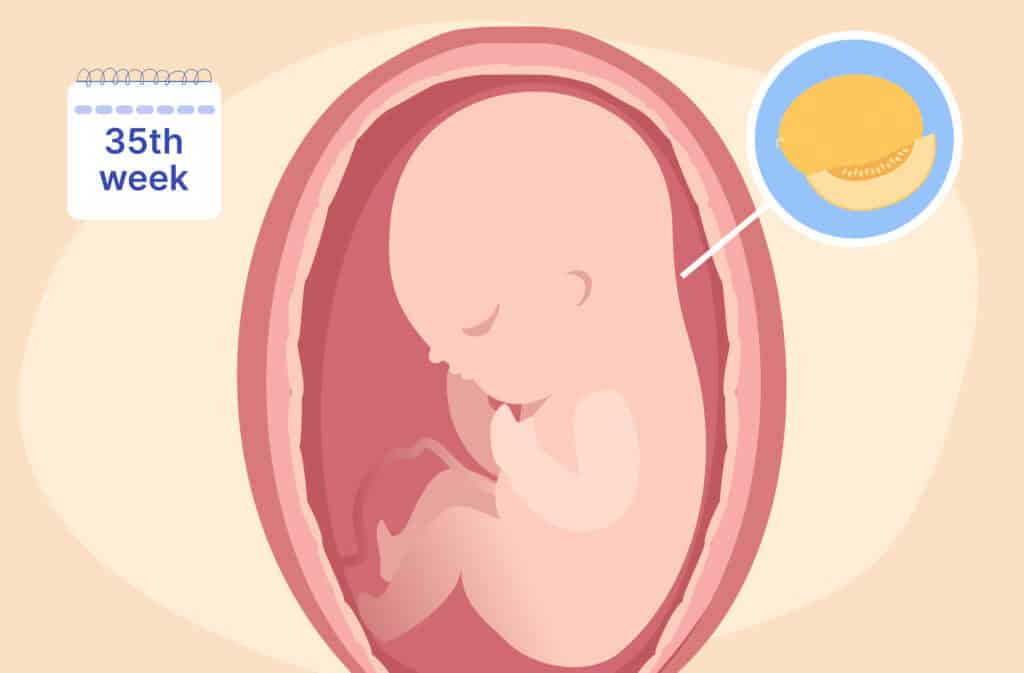
Discover what happens at 35 weeks pregnant, from baby development and symptoms to concerns about sex and breastfeeding benefits.
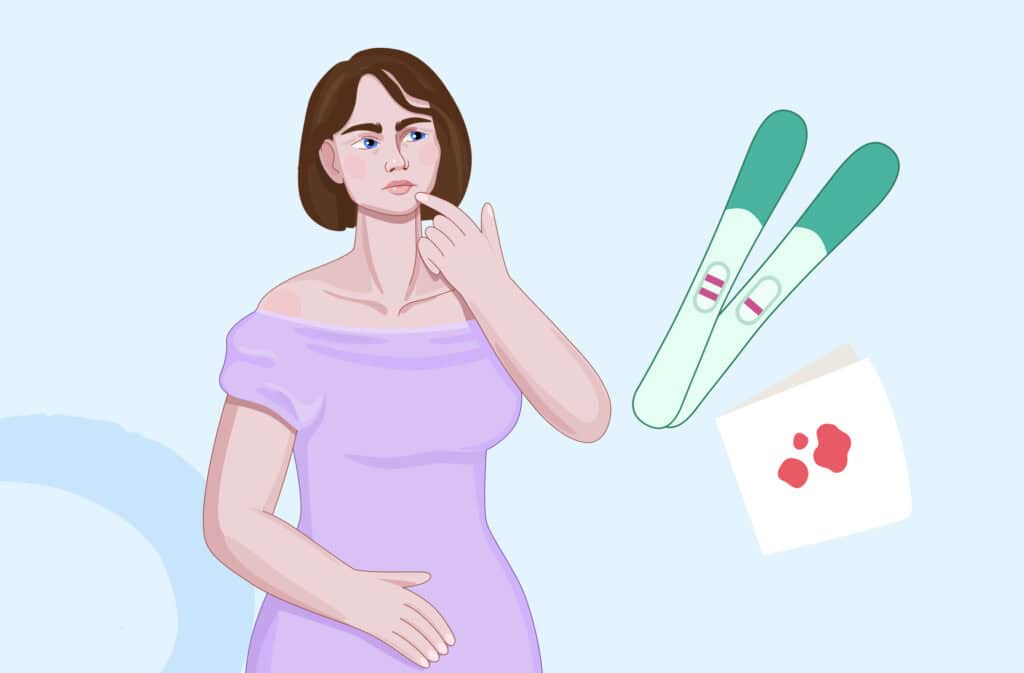
Learn about chemical pregnancy symptoms, causes, and frequency. Discover how to recognize this early pregnancy loss and when to seek medical help. Expert advice from Femia.
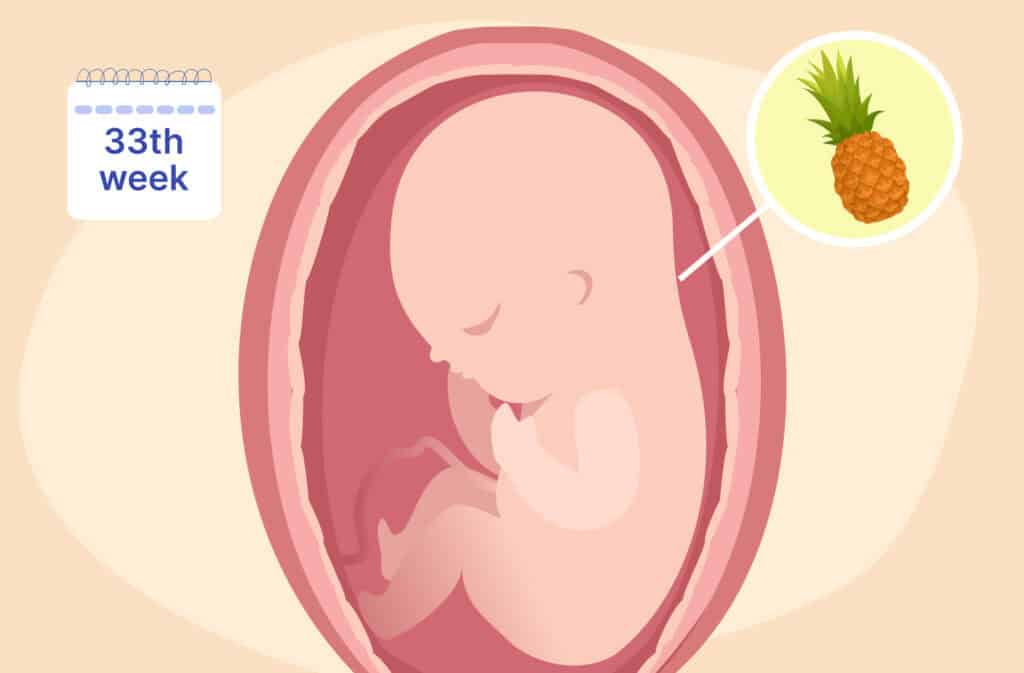
Discover what happens at 33 weeks pregnant, from baby development and labor signs to the pros and cons of having a partner during delivery.

